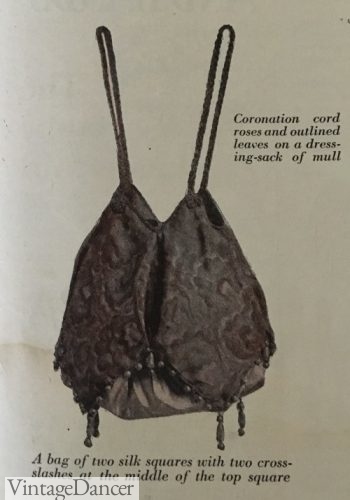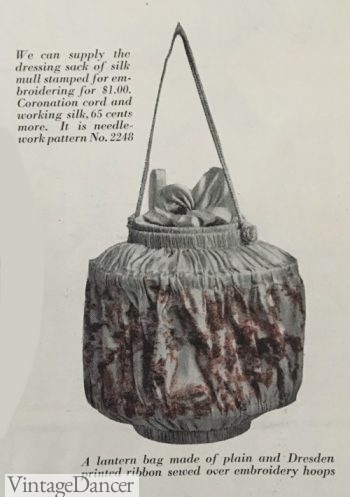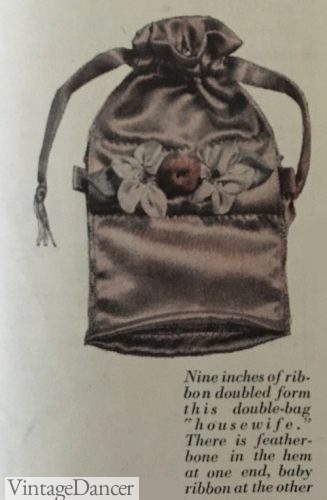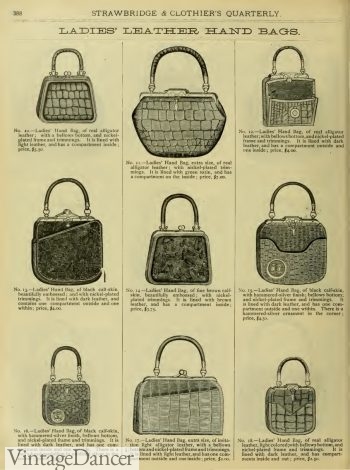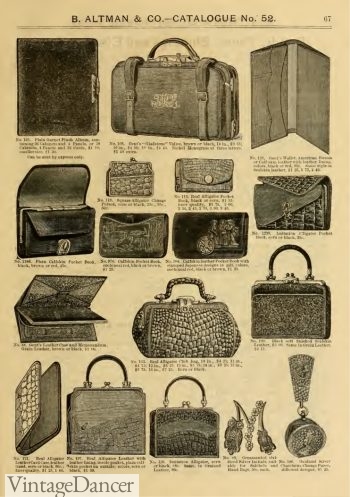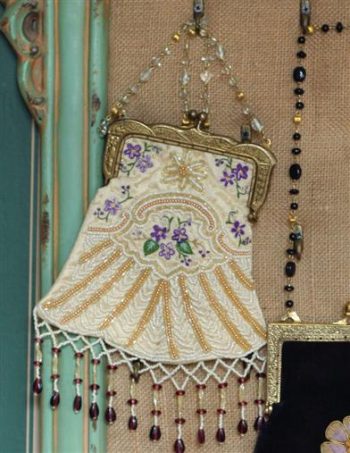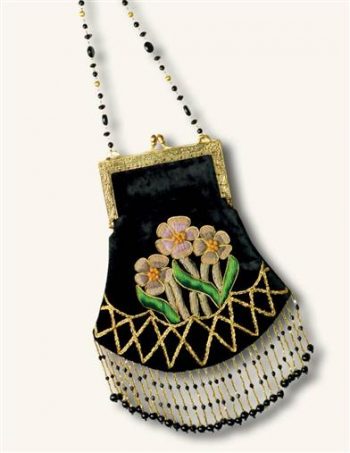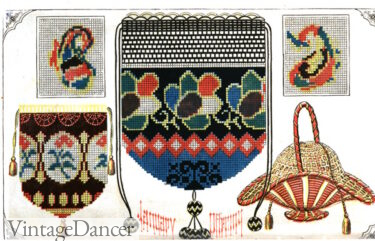
1860s Victorian purses and basket
Victorian purses have a slow building history among women. While not a new invention, the need for purses increased, especially among the middle classes who could afford to go shopping but not be in the company of servicemen at all hours.
The real reason for needing a purse was not motivated by shopping, but by social interaction. A lady would visit her friends in the afternoon, leaving calling cards upon her arrival. Carrying cards, pencil, and a handkerchief in a small purse was not only convenient, but showed off her handicraft talents as well.
The handmade purse was a little thing of beauty, painstakingly made to perfection.
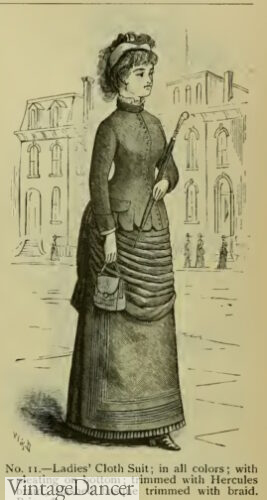
1883 small leather purse
As the Victorian era moved closer to the Edwardian era, other types of bags emerged that were closer to what we think of as handbags today. During the day, leather frame bags with handles were small but practical.
Some, called Chantelaines, were clipped to a belt for hands-free convenience. Upper-class ladies and evening attire called for Victorian beaded purses, silk drawstring reticules, or metal mesh bags.
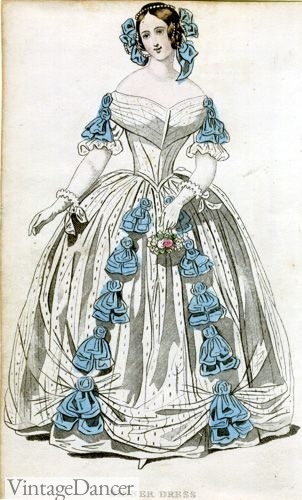
1840 reticule purse
For the working poor in both Victorian and Edwardian societies, a large woven basket was the most practical shopping bag. The cheap carpet bag was used by all classes when traveling for short durations, including our favorite nanny Mary Poppins.
Read on about the history of 19th-century Victorian purses and early 20th century Edwardian purses and learn where to find reproduction or inspired purses for your Victorian costumes.
** This article is sponsored by Victorian Trading Co., purveyor of Victorian fashion and home decor. Links within may be affiliate links, meaning at no cost to you, we may receive a commission for purchases made after clicking. **
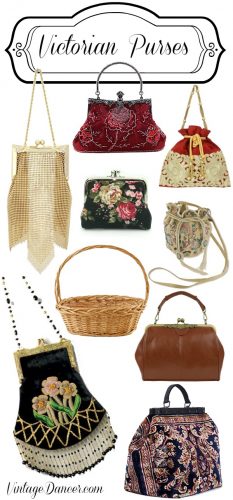
Victorian style purses for sale online
Victorian Reticule Purse
The Victorian purse, although not new to the era, was one that was becoming more commonplace among women who were no longer confined to the home. Up to this point, most women’s fashions were void of any pockets in which to carry small belongings.
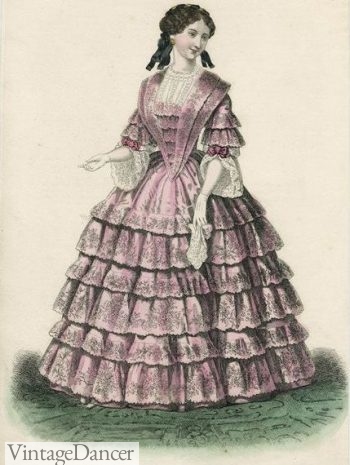
1852 flounced dress with matching lace reticule
The hanging pocket or reticule bag had been the one purse style that allowed middle and upper-class women to go shopping, traveling, visiting friends, and leaving calling cards with ease. It was carried in hand, shaped like the inside of a pocket. It held only a few critical items such as a handkerchief, fan, pencil, and cards.
There was little difference between day and evening reticule bags — both were heavily decorated with beads, needlework, or were trimmed in lace and ribbon.
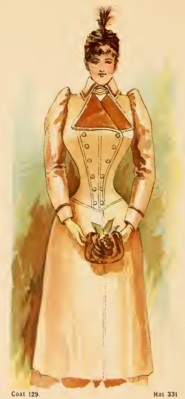
1897 lady holding reticule drawstring bag
Victorian reticule bags (jokingly called indispensables in Britain) were decorated in patterns of roses, birds, buttercups, and daisies made of small beads or embroidered wool. Fancy ones were trimmed in ribbon, braiding, tassels, and fringe. Plain ones were made of silk and were more practical for daytime.
They had either drawstring tops or were sewn flat and stiffed with card. Most reticules were handmade at home by ladies to show off their feminine skills.
The easiest handmade purse was the crochet or knit purse of silk yarn. They were round in shape, with a tassel at the bottom and a drawstring at the top. Most men and some ladies had a similar small purse made of kid leather that was used to hold tobacco.
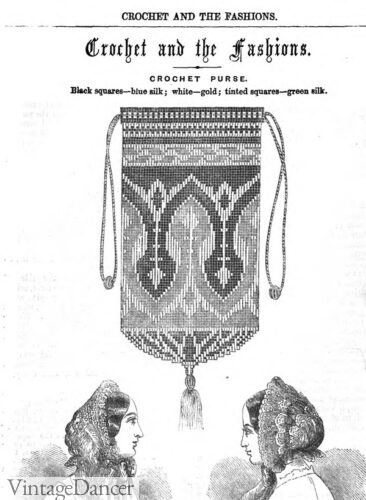
1853 crochet reticule pattern
Long tube shaped reticules with or without a tassel dangling from the bottom came by many names such as stoking purses, miser purses, ring purses, and finally just long purses. Its history extended back to the 17th and 18th century. Victorian designs favored the color green, silk crochet, netting, needlecrafts, and/or heavy beading.
It was customary for men to carry the same type of purse complete with steel beads and tassel!
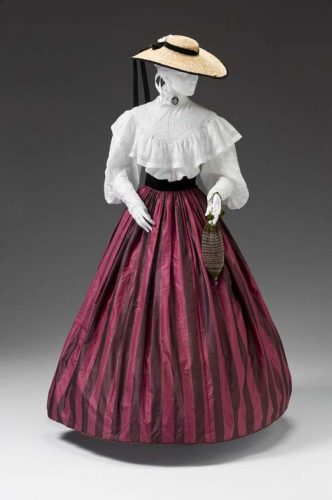
1850-1860 Reticule purse with outfit, The Mint Museum, Charlotte, North Carolina.
In the 1830s and 1840s, silk cross stitch on canvas formed most reticule flat bags. In the 1850s and 1860s, Berlin wool work replaced silk. Berlin wool was soft merino wool that was imported to Berlin, Germany to be dyed in bright colors.
The wool was easy to stitch in mostly single rows, following chart designs frequently provided in ladies’ magazines and newspapers. The final results were colorful blooming florals with a textured tapestry feel. Square, rectangle, and pocket shaped purses were the most common and easiest to create by the home maker.
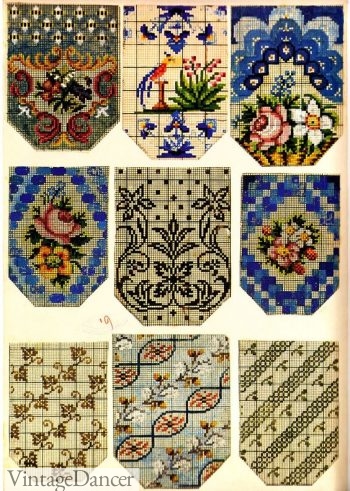
Berlin Wool Work designs
From the 1860s onward, decorated fabrics were only one of many material styles. Bags and coin purses were made of metal, raffia, leather, velvet and ivory too. Those made of stiff outer material were lined in soft silk on the inside.
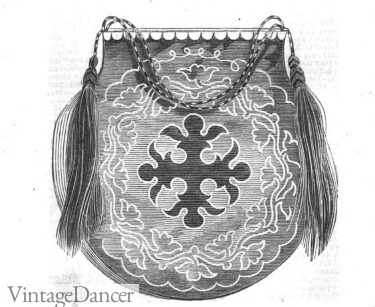
1855 velvet embroidered reticule with frame top
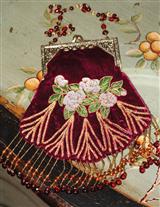
Beaded Victorian purse at Victorian Trading Co
As skirts widened in the 1850s and 1860s, the use of a handheld reticule was replaced by hidden pockets in the dress. Although they could be fairly large, they were not supposed to be noticed. Carrying handkerchiefs, letters, a notebook, a calling card case, and money all in one pocket could lead to a bulging appearance.
A respectable lady had to be aware of the number of things she carried when she left the house and only take what was small and absolutely necessary.
Purses of this decade, when used, were very small, with short cord handles in the reticule or purse shape as seen below. For evenings, a fussy lace or ruffled reticule matched the style of gown.
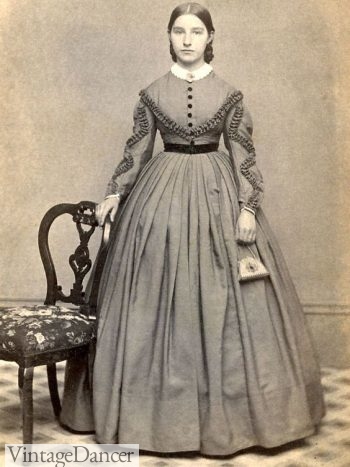
1860s woman with a hard sided purse- day wear
Victorian Chatelaine Bags
“For some time past, chatelaine bags have been very popular in England. They have been worn at the side suspended to the waistband. These have generally been made of leather and studded with steel, and for traveling have been found very convenient. For home wear, they are made of gimp or embroidered velvet.” Queen, 1863
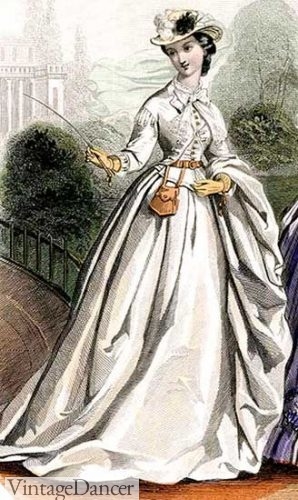
Riding habit with leather chatelaine purse
Chatelaine bags were on trend from 1860 to 1900. Chatelaines bags hung from the waist and could be flat fabric or a leather frame bag with one or two chains, ribbon, or cord handles joined together in a clip that slid over a belt, sash, or chain around the waist.
In the 1860s, the bag was usually flat and outlined in silk cord with tassels at the top corners.
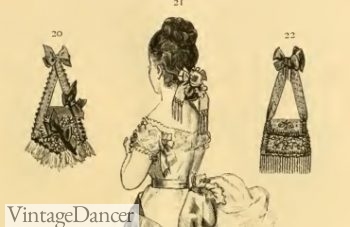
1874 “These chatelaine bags are of the shape most worn, and are attached at the waist by a brooch pin concealed beneath a bow. One is trimmed entirely with bugled lace, – the other with beaded gimp, having a bugle fringe.”
Closer to the 1870s, the card purse had three points, each with a tassel and a cord handle.
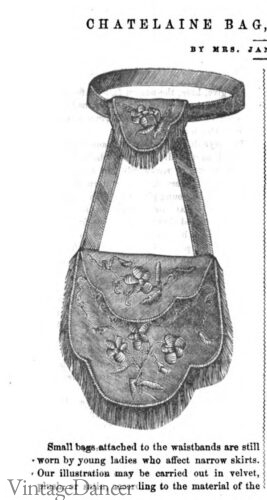
1882 embroidered chatelaine bag with belt
1880s chatelaine bags were made of velvet, satin, fur, or plush. They had only simple embroidery and trim, letting the rich fabric speak for itself. Small silver metal chatelaines were also common, but only big enough to hold a few coins.
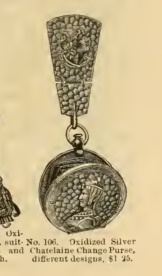
1886 silver chatelaine lip and coin purse
The 1890s saw a return to embellishing with ribbon, a flashback to the 1830s. By the late 19th century, leather bags in similar shapes were preferred over anything homemade.
They were very practical for the lady on the move as it allowed her to keep her hands free but necessities nearby. It also reduced the number of purse snatchings, which were becoming a problem in cities.
In the country, women used a leather chatelaine purse while out riding horses. During WWI, nurses wore a similar variety to carry medical tools with them. Why do we not have something like this today? I would use it!
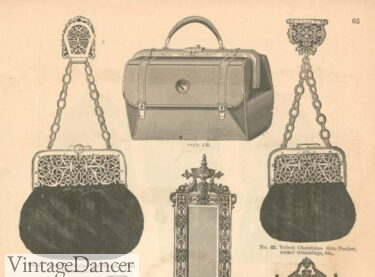
1879 R and L – framed silver top and velvet body Chatelaine bags
Reticule Victorian Purses
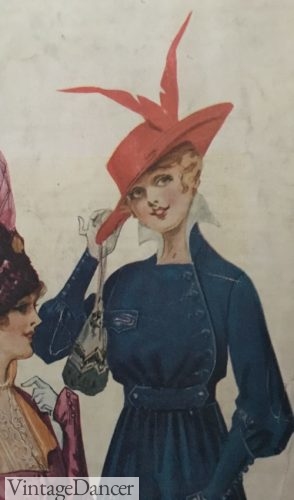
1916 drawstring reticule
The reticule adapted into new forms after the turn of the century.
The Dorothy bag was made of soft materials and a drawstring top, just like a Victorian reticule. It was often covered in beads and included a tassel bottom lined with silk, cotton, or velvet with a long cord or ribbon handle that hung at knee level.

1882 velvet, satin and lace Dorothy bags
(Top) Made of gold satin, it measures 6.5 inches. Trimmed with gold lace and edged at the top with a pleating of silk plush, over a wide pleating of satin. Two ruffles in the centre of rich shades of green and crimson with matching embroidery.
(Bottom) Moss-green embroidery silk and gold thread are used for the stitching. The bag is edged with heavy green-silk cord, and a deep pointed fringe of red silk tassels and gold cord. The bag is drawn up by a red silk cord, and finished at the sides with small red and green silk tassels.
Some Victorian reticules were embellished with steel beads instead of glass beads. Many had a beveled mirror inside the bag, a hidden tool for applying makeup.
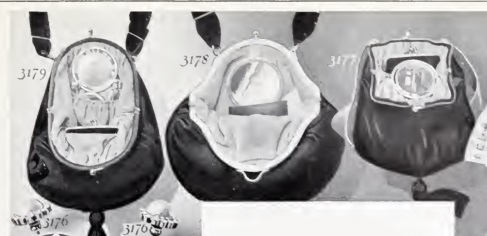
1914 evening bags with built-in mirror
Small purses with wrist straps improved on the design. There were bags for specialty uses, such as attending the opera.
Opera bag held opera glasses, a program, mirror, and a fan.
Dance bags were designed to carry delicate silk dance slippers to a ball where travel in boots was necessary first.
Turn of the century specialty bags were often made of colorful dyed suede, a new material that was both pretty and durable, unlike silk.
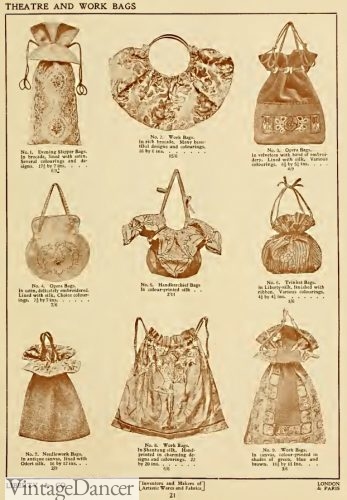
1911 opera, dance and specialty evening bags
In 1910, fashion took inspiration from the orient. Beaded and embroidered bags featured scenes, objects, and people in the oriental art style. Frames were carved from ivory or bone.
Colors drifted to gold, red, and black combinations. The lantern shaped bag (middle below) mimicked Chinese Lanterns and were often embroidered with scenes in China. Other styles used boning, cardboard, and embroidery hoops to create support for 3D shaped purses.
- 1914 silk two strap bag
- 1914 lantern shape reticule bag made with embroidery hoops
- 1914 simple reticule bag
How to Make a Victorian Reticule Bag
- Start with two 6 by 10 inch “pocket shape” pieces of fabric (lining is optional). Add embroidery, beading or trim now before sewing the pieces together.
- Starting 1 inch down from the top edges, sew the purse all around the sides and bottom. Hem/serge the top edge.
- Turn down the tops of each side to make a casing. Sew the top edge and again about 3/8 below that.
- Put the drawstrings through the casings and tie knots in the ends. Add a long tassel or fringe to the bottom of the reticule for evening styles.
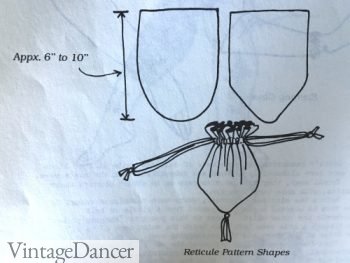
Cutesy of Victorian Costuming V1 by Winter and Savoy
Tip: Not inclined to sew? Drawstring reticules are available to purchase at low cost. One of my favorite lesser-known sources are Potli bags. They are used in Indian evening and wedding affairs. The designs favor traditional Indian art and design, which works perfectly for the British Victorian era when they ruled India from 1958 to 1947.
Americans didn’t receive as many Indian goods as the British, but the simple designs work well for the era none-the-less.
Leather Handbags
The 1880s and 1890s were decades known for small leather frame handbags and clutch pocketbooks. These finally resemble what most handbags look like today.
All kind of leather and reptile skins were used to make handbags. A clasp frame or kiss lock on top and a stiff body with a round leather handle made them very durable to ladies on the go.
Inside an additional coin purse or larger pocketbook would hold cash and a notebook with pencil.
- 1882 leather handbags
- 1886 bags and purses
Victorian style leather frame bags came back with a vengeance in the 1950s. Many “vintage kiss lock bags” can be used in Victorian era costuming.
Victorian Beaded Bags, Evening Bags
- Ivory beaded Victorian style bag
- Black Victorian Beaded Purse
Heavily beaded reticules, chatelaines, and framed Victorian purses were a work of art. Up to 1000 beads per square inch could decorate a purse before 1850. This type of fine beadwork created a bag that looks tapestry-like. Not to be confused with real “tapestry bags” that were made of woven yarns, mostly to hold women’s needlework supplies. As the century progressed, slightly bigger glass beads and more space was beaded into the bag design.
Gilt beads, steel beads, and some bugle beads were used on purses in the 1850s and 1960s. Tassels were made of the same beads on the bag body. To keep the beads securely attached, special “purse silk” or “netting silk” was used.
The early 20th century also saw Native American beaded bags become major fashion items. Unlike Victorian beaded bags, these bags were made of soft chamois and decorated with a few brightly colored beads. Cut fringe replaced long beaded fringe and silk cord acted as the handle.
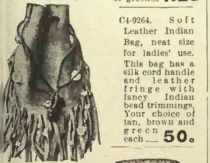
1909 Native American style bag
Purse frames were quite ornate, being made of solid gold, sterling silver, nickel, amber, ivory, or celluloid. They were heavily engraved or embossed in filigree scroll with gemstones, pearls, and enamel art accents. The frames opened and snapped closed, providing some security to the contents inside. The early 20th century saw the use of the new kiss(ing) lock. They were used mostly on small coin purses instead of bags.
Tip: I love the beaded bag collection at Victorian Trading Co. Additionally, you can find them sold online made with cheaper sequins or plastic beads, but they are not as nice as glass beads. Occasionally, they come back in fashion long enough to be sold in the evening / wedding section of your favorite department stores.
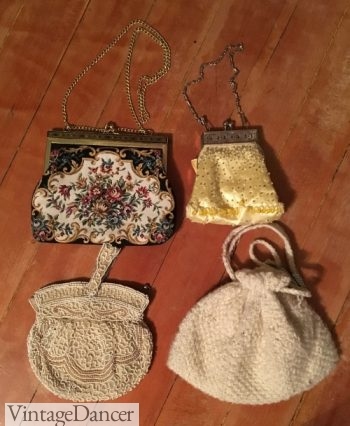
A few of my Victorian style purses I use (Top two are repro, bottom two are vintage)
Metal Mesh Victorian Bags
“Ladies of the middle classes… in hansom carriages as they paid afternoon calls. Their white kid gloves were of immaculate quality. Over one wrist they carried a small, square, gold mesh bag containing a gold pencil, a handkerchief, and a flat gold wallet which held their calling cards.” Cecil Beaton, The Glass of Fashion.
Bags for different seasons were also a welcome design. The crochet mesh bag was an airy summer accessory that lasted well into the 1930s.
Metal mesh bags were another popular style most notably made by Whiting and Davis starting in 1882. They were constructed of silver or base metal rings intricately joined together into a fine mesh. They looked a bit like chainmail armor from the Medieval days. The inside could be lined with a soft silk of the same gold or metal color, or lined in a contrasting cheerful silk or suede. The frames were richly studded with precious stones such as pearl, amethyst or turquoise. The snap frames, kiss locks and twist locks could be decorated as well.
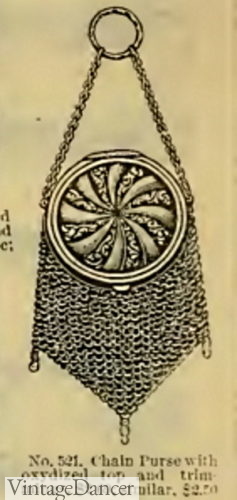
1890 chain mesh purse
Mesh bags were masculine and military feeling, yet pretty with a decorative frame, clasp, and “fringe” bottom. They increased in popularity in the 1920s, when color screen-printing allowed pictures of flowers and fruit to be printed on the metal. Naturally, they made an elegant choice of a purse for afternoon and eveningwear.
For a lady who did not a need to carry a purse, metal coin purses worn around the neck was a useful substitute for brief outings. These were also tied or clipped at the waist, Chantelaine style, in the early Victorian years.
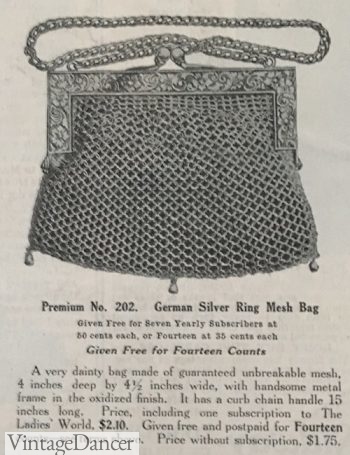
Silver mesh bag
Tip: Metal mesh purses never went out of style after the Victorian era. You can find vintage bags from the ’50s to the ’80s that look very similar to Victorian and Edwardian era mesh bags. I have a Whiting and Davis vintage bag that I often use with my Victorian evening gowns. Whiting and Davis still makes beautiful mesh bags. They cost a small fortune, but they are worth it!
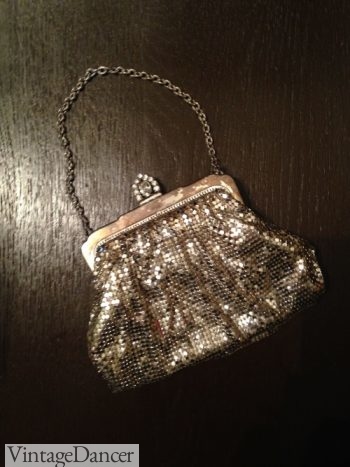
My 1950s does Victorian mesh bag
The Victorian Carpet Bag
Fueled by greater mobility and the adventurous thrill of travel by train or ship, luggage became a necessity. The carpet bag experienced a surge in popularity in the 1850s to 1870s.
It was large and roomy, but portable enough to be carried by a woman. They were made from scraps of rolled silk carpet (often used/pre-owned) with a wide bottom, and collapsed at the top with two short leather or wood handles.
They were cheap to make and cheap to buy at only $1 to $2 at a Dry Goods store. Every class of person owned and used a carpet bag for light travel.
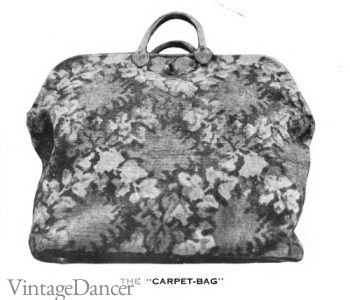
Victorian carpet bag
They became so synonymous with travel that any out of towner was easily recognized by the carpet bag they carried. Many American northerners moved south after the Civil War to take advantage of cheap farms.
The name “carpetbagger” was not a kind one. It is defined as “an outsider involved in politics.” In the south, those politics involved cheating southerners out of their land, wages, and quality of life. More info.
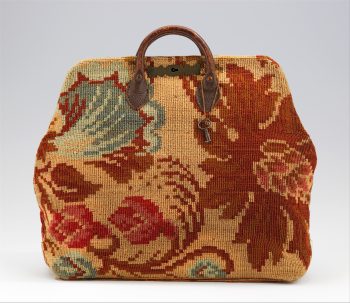
Carpet Bag. 1865. Brooklyn Museum Costume Collection at The Metropolitan Museum of Art, Gift of the Brooklyn Museum, 2009; Brooklyn Museum Collection
The most famous Carpetbag belonged to the loveable nanny, Mary Poppins. She traveled into the Banks’ house with it and surprised the children with the magic inside. There were many stories of nannies and their carpet bags full of fun toys.
Children came to expect that a visit from a family member accompanied by a colorful carpet bag meant a special toy or treat was inside.
Victorian Leather Travel Handbags
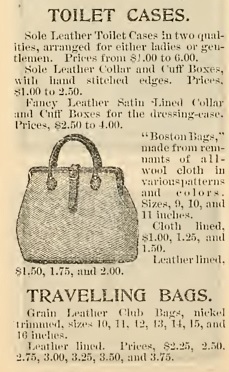
1895 leather travel bag
Other handbags emerged from the carpet bag’s simple and durable design. Louis Vuitton made a travel bag of waterproof canvas and lacquered iron. Leather bags followed with locks, keys, and multiple compartments.
A large bag with a metal frame called the Gladstone bag, after Queen Victoria’s Prime Minister William Gladstone, was used for women’s travel. They looked like vintage suitcases.
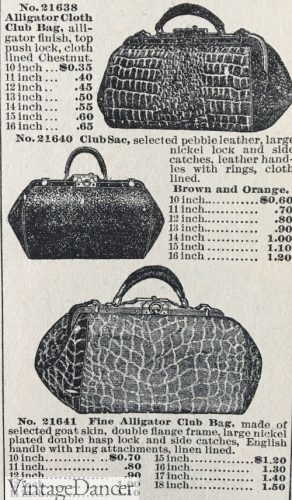
1892 Club bags
The club bag was another travel bag that was adapted for women. The club bag is most well known as a doctor bag. They were quite large but could come in smaller sizes for women. Bags snapped closed with a frame, had multiple compartments, and were otherwise more practical than pretty.
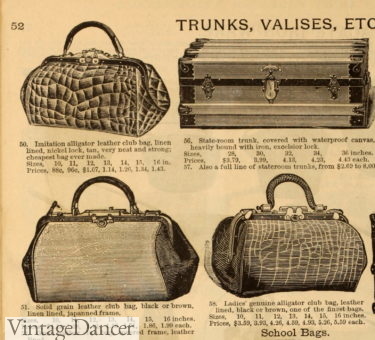
1890 small luggage club bags and a trunk
Victorian Shopping Baskets and Bags
A working-class woman was not able to go about her business without the use of a larger basket or bag. Servants of the wealthy also used large woven baskets to go to market, pack a picnic, or assist a lady with her shopping. The basket came in several forms. The market basket was an open top with one or two handles across the center.
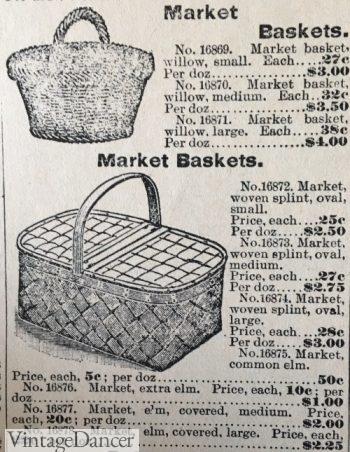
1892 woven market baskets
Early versions were almost always round, while later styles could be shaped like a picnic basket with flap tops. Some were deep, some were shallow. They were woven from willow, elm, or split basket weave. Almost all had large handles to balance over a forearm.
The basket hung over the woman’s shoulders below is carried by a leather strap. She also wore a gathered apron of sorts, probably to hold her money.
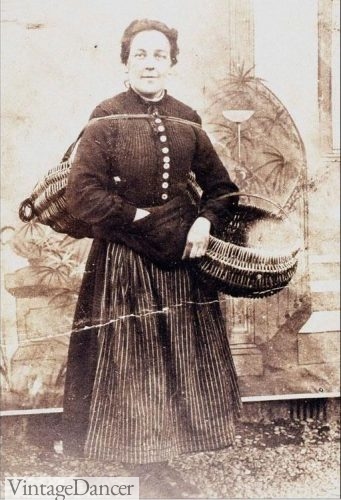
1860s shopping baskets
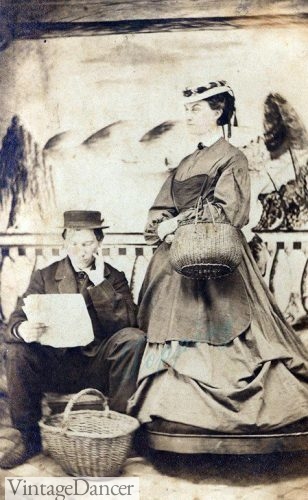
1850s Victorian shopping baskets
Middle class women who went to the market or out shopping often decorated their straw baskets with ribbon, bows, pom-pons, embroidery, lace, and old brooches. They were often lined in a soft fabric like cashmere or velvet and pulled closed with a drawstring top. The decoration set them apart from the lower classes. I find the drawstring top inside the envelope shape bag to be an interesting blend between basket and reticule purse.
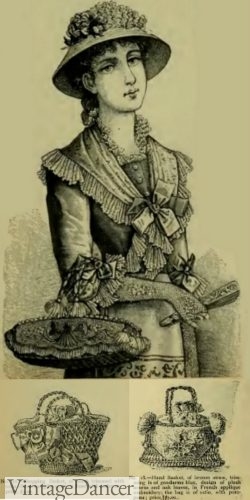
1883 Decorated Shopping Baskets
The Boston Shopping Bag below is described as “7 x 11 inches, has two handles, outside pocket, cloth top with drawstrings. ”
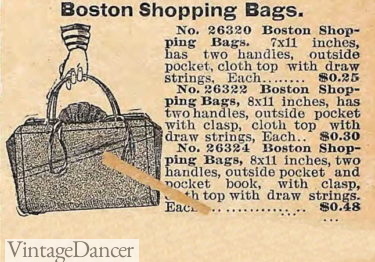
1897 ladies Boston shopping bag
Victorian School Bags
Victorian bags for school age children looked like large simple flat leather, canvas, woven or rubber purses with a single long strap or short two handles. They could also look like a modern laptop bag with leather trim and long strap with a fold over flap.
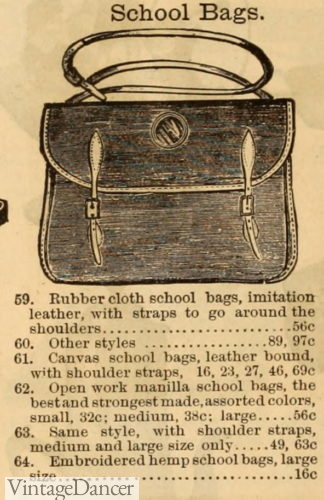
For lunch a drawstring bag was all that was needed.

1896 School bags
Shop more Victorian style purses and shopping baskets here.
Read the next article about Edwardian era 1900-1910s purses.
Debbie Sessions has been teaching fashion history and helping people dress for vintage themed events since 2009. She has turned a hobby into VintageDancer.com with hundreds of well researched articles and hand picked links to vintage inspired clothing online. She aims to make dressing accurately (or not) an affordable option for all. Oh, and she dances too.
